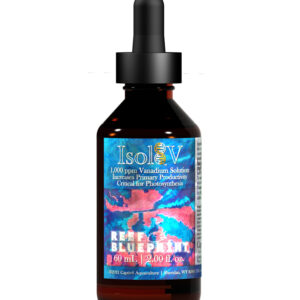Iron sol’n; 10,000 ppm; stable at seawater pH. Increases iron, arguably the most important trace element to photoautotrophs (including zooxanthellae), in recirculating seawater systems, particularly those employing turf scrubber filtration. Required for photosynthesis, electron transport, nitrogen fixation, antioxidant activity, pigment production, and reduction of nitrite, nitrate, and sulfate. 1 drop (0.05 mL) per 2,365 gal. (8,953 L), once daily to maintain NSW value for S=35. 10,000 ppm iron, derived from chelated iron (anhydrous, USP).
Parameter
Iron
Value
10,000 ppm
Characteristics
- Increases iron, arguably the most important trace element to photoautotrophs (including zooxanthellae), in recirculating seawater systems, particularly critical in those employing turf scrubber filtration.
- Required for photosynthesis, electron transport, nitrogen fixation, antioxidant activity, pigment production, and reduction of nitrite, nitrate, and sulfate.
- Improves color intensity of zooxanthellate invertebrates, particularly in blue, green, and yellow hues.
- Aids in the reduction of nitrate.
- Active Components: Chelated Iron (proprietary form), anhydrous, USP.
Basic Application
- Recommended: dilute 1 drop (0.05 mL) Isol8 Fe in 100 mL of purified water, and dose 1 mL of this solution per 23.7 gallons (89.5 L) daily. Label and date solution, and keep tightly-capped when not in use. Uncontaminated solution will remain viable for ≥2 years.
- Reference Standard [Fe]: 5.59×10-5 ppm (S=35.0)
- In established systems, increase [Fe] up to 5% of existing ionic value daily, until desired value or reference standard is reached.
Application
Keep out of reach of children and unauthorized persons. Avoid contact with skin, eyes, and mucous membranes. Store in a cool, dry location away from sunlight.
All trace elements critical to continued functioning of photoautotrophs, including iron, are provided in Isol8 MT, which offers a simpler method of dosing the aforementioned elements in ratios mirroring those of natural seawater, and is recommended for general husbandry of recirculating marine ecosystems. However, iron is one of the handful of trace elements in which individual dosing is encouraged (in addition to Isol8 MT), due to iron’s importance to photosynthetic processes and the elevated rate of uptake relative to several other trace elements, particularly in recirculating marine ecosystems with dense populations of photoautotrophs and/or which employ algal turf scrubber filtration as a means of natural nutrient reduction. Although we recommend that regular analysis be performed to verify iron content and to provide a baseline value for future adjustment, there is positive visual feedback associated with iron dosing and, in some systems, this may be adequate to guide the user in modifying dosing rate to suit cohort requirements. To obtain accurate iron values,
The rate of ion depletion due to photoautotroph uptake is driven by various chemical and physical factors which are unique to each independently-operating recirculating system, and which are constantly changing as photoautotroph biomass increases and decreases.
Monitoring (daily) the system’s concentrations of elements provided by this formulation, as well as the concentration of nitrate, and referencing apparent changes in coloration of zooxanthellate cnidarians will enable User to adjust dosing of this formula to suit system requirements, improving overall effectiveness and resulting in less wasted solution.
Users unable to perform analyses for elements provided by this formula are recommended to monitor nitrate concentration and apparent changes in coloration of zooxanthellate cnidarians, adjusting dosage to suit system requirements. This visual approach to dosing is fastest, and for many systems will be adequate.
Recommended is diluting an appropriate volume of this solution into a larger volume of purified water (with a purity of at least 98%), and applying this diluted solution to the system with an automated dosing system throughout the photoperiod. Dosing frequency is directly proportional to stability of ionic concentrations and, resultantly, gradual changes in the coloration (manifesting as intensification) of coloration of zooxanthellate cnidarians. A 1 – 10 s drip interval during the photoperiod provides adequate ionic stability, and is recommended.
If no automated dosing system is available, then apply solution manually each day. Dosing frequency is directly proportional to stability of ionic concentrations and, resultantly, consistent changes in coloration of zooxanthellate cnidarians. Dosage volume per 24 h is divided by the dosing frequency.
It is not recommended that this formulation be dosed fewer than four times weekly.
Reference Standards: 1 drop (0.05 mL) Isol8 Fe diluted in 26.4 gal. (100 L) water yields 0.005 ppm increase of [Fe]. Undiluted, 1 drop treats a volume of 2,365.3 gallons (8,952.6 L) at the reference standard of 5.59×10-5 ppm.






